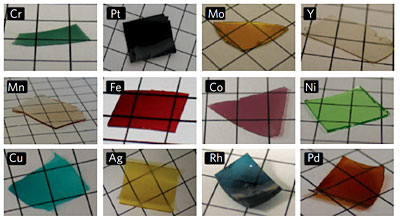A research team from the Cornell University has devised a new technique to fabricate porous metal films with an electrical conductivity 1000 folds higher than that can be achieved by earlier methods.
 Samples of self-assembled metal-containing films made by the new sol-gel process. The films are essentially glass in which metal atoms are suspended, which imparts the color., Grid lines are 5 mm apart. (credit:Wiesner Lab)
Samples of self-assembled metal-containing films made by the new sol-gel process. The films are essentially glass in which metal atoms are suspended, which imparts the color., Grid lines are 5 mm apart. (credit:Wiesner Lab)
This technique paves the way to fabricate a broad array of metal nanostructures for biomedical and engineering applications. The study findings have been reported in the journal, Nature Materials.
The novel technique is based on the ‘sol-gel process,’ wherein some silicon compounds dispersed in solvents will develop into a honeycombed silicon dioxide structure with nano-sized pores through self-assembling.
Nearly a decade ago, a research team of Ulrich Wiesner from the Cornell University together with the Cornell Fuel Cell Institute made an effort to utilize the sol-gel process with catalysts that remove protons from fuel molecules to produce electricity. Scott Warren, who was then a member of Wiesner’s team and is now a scientist at Northwestern University, informed that the researchers needed high conductive materials, but the addition of more than a trace amount of metal had affected the process.
Warren proposed the use of an amino acid to bond metal atoms with silica molecules. He explained that the phase separation that affects the self-assembly process can be eliminated if it is possible to bond the metal atoms to the silica sol-gel precursor. This technique produced a nanostructure composed of carbon, silica and unprecedented levels of metal, thus improving the conductivity significantly. A porous metal can be produced by removing carbon and silica. Warren informed that when the silica alone is removed, it results in a carbon-metal complex that offers other features such as larger pores.
Using the novel technique, the researchers have synthesized structures of virtually all metals in the periodic table. The pore sizes ranging between 10 and 500 nm can be altered through additional chemistry. Wiesner stated that using the simple one-pot mix-and-heat technique, the researchers were able to produce materials with unprecedented levels of control over nanostructure, composition and functionality such as conductivity.
The researchers have also synthesized metal-filled silica nanoparticles, which can be swallowed and released by humans, thus opening the door for potential biomedical applications. This technique might be used to fabricate Graetzel solar cells containing light-sensitive dyes.